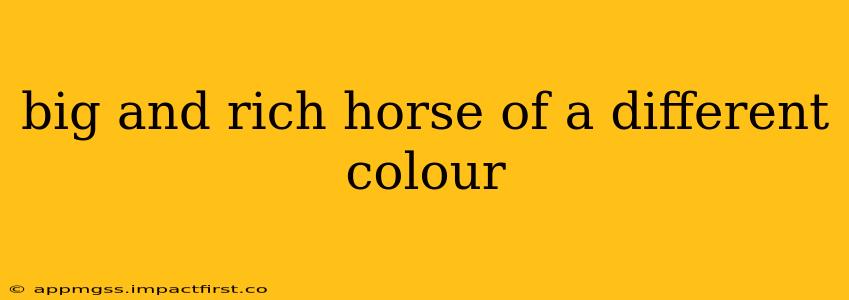The Big, Rich Horse of a Different Color: Exploring the Metaphor
The phrase "big and rich horse of a different color" isn't a standard idiom like "a horse of a different color." It's a playful, slightly awkward expansion on the original phrase, emphasizing the unusual and perhaps extravagant nature of the subject being discussed. Let's break down what this extended metaphor implies and explore its possible interpretations.
The original idiom, "a horse of a different color," signifies a completely different matter or situation. It suggests a significant departure from the previously discussed topic, implying a change so substantial that it requires separate consideration. Adding "big and rich" intensifies this difference, highlighting aspects of size, opulence, and perhaps even extravagance.
Think of it this way:
-
"A horse of a different color": This represents a simple shift in topic or perspective. It's like comparing apples and oranges—they are different, but not necessarily dramatically so.
-
"A big and rich horse of a different color": This indicates a much more significant divergence. We're not just talking about different fruits; we're comparing a common apple to, say, a rare and expensive golden apple grown in a faraway land. The scale, value, and unique nature of this “golden apple” are emphasized.
What does it mean in context?
The meaning depends heavily on the context. It implies a significant shift in circumstances, often involving:
- Scale: The new situation is much larger, more extensive, or more impactful than the previous one.
- Value/Wealth: The new situation is more valuable, significant, or luxurious than the original.
- Uniqueness: The new situation is exceptionally rare, different, or unusual.
What are some examples of how this phrase might be used?
Imagine a business negotiation:
"We initially discussed a small marketing campaign, but this new proposal—a massive, multi-million dollar international advertising blitz—is a big and rich horse of a different color!"
Or in a personal context:
"I thought we were just going for a walk in the park, but this invitation to a luxurious weekend getaway at a five-star resort is a big and rich horse of a different color!"
What is the difference between this and "a horse of a different color"?
The core difference lies in the emphasis on scale, value, and uniqueness. "A horse of a different color" simply signifies a change; "a big and rich horse of a different color" highlights the magnitude and quality of that change. It's a more emphatic and expressive way of conveying a significant shift.
Is it grammatically correct?
While grammatically unconventional, it's perfectly understandable in informal contexts. The awkwardness of the phrase contributes to its playful and emphatic nature. In formal writing, sticking with the original idiom, "a horse of a different color," is usually preferable.
How can I use this phrase effectively?
Use this phrase sparingly and strategically. Its effectiveness relies on its unexpected nature. It works best when the contrast between the original topic and the new one is stark and easily understood. It's a phrase that can add humor and emphasis, but overusing it will diminish its impact.
In conclusion, "a big and rich horse of a different color" is a vibrant and evocative extension of a common idiom. Its added descriptive elements make it a powerful tool for emphasizing significant and extravagant changes in circumstances. However, remember to choose your words carefully, ensuring the context justifies this colorful and unconventional expression.
